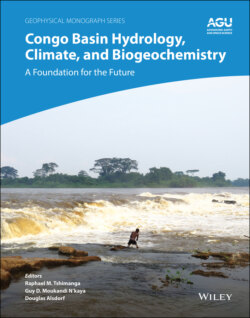Читать книгу Congo Basin Hydrology, Climate, and Biogeochemistry - Группа авторов - Страница 58
Methodology
ОглавлениеThe range of experience extends from 17.5°S to 17.5°N and 30°W to 80°E. This domain is large enough (Figure 4.1) so as to take into account the climate continuum of Central Africa, which depends heavily on the Indian Ocean and weakly on the Atlantic Ocean. This area is chosen to include climatic factors at the local level, but also to account for the diversity of African weather patterns. The domain to be modeled is Central Africa, which extends between longitudes 5°E and 35°E and latitudes 15°S and 15°N. A finite‐difference horizontal discretization is done with square meshes of 40 km (i.e. 0.36° × 0.36°) on each side. At this resolution, RegCM can better represent orographic forcing than reanalyses, for example. The experiments were carried out over seven years (from 1 January 2000 to 31 December 2006), with one year of “spin‐up” excluded in the study period. This study period is chosen because it includes two years that did not experience extreme rainfall anomalies, namely the years 2004 and 2006. Therefore, the period from 2000 to 2006 presents a wide range of rainfall variability over the study area (Mbienda et al., 2016). We have done experiments with the Grell convective scheme (Giorgi et al., 1993), which was identified by Mbienda et al. (2016) as a suitable RegCM convective scheme for simulations in Central Africa. To examine the influence of slab‐ocean parameterization, we carried out two different experiments with RegCM: The first experiment without slab‐ocean, which we call GFC_CTR, is designed for the climatology of the different parameters of the model and activates the SOM surface flux that forces the surface boundaries of RegCM with SST without modeling the ocean–atmosphere feedbacks. The second slab‐ocean experiment, which we call GFC_SLAB, is designed to couple RegCM with the SOM and is identical to the first experiment except for the activation of the slab‐ocean. It provides mutual interaction of the atmosphere (RegCM) and the ocean (SOM). It uses SST and the climatology created in the first experiment to model the ocean–atmosphere interaction by modulating SST. In this experiment, different methods are adapted to the model to reduce errors due to the complete absence of ocean dynamics in the SOM. The model then uses the q‐flux adjustments in SOM to improve the representation of the seasonal cycle of SST. This q‐flux is obtained by performing a calibration experiment (restoration cycle), during which the observed SOM prognostic SST is established over a five‐day interval, then archived and saved in an average monthly climatology for the period 2000–2006. Different statistical approaches have been adopted to estimate the skill of the model according to the different experiments in the different homogeneous sub‐regions and the Central African domain as a whole. We used statistical tests such as (i) the bias that measures the difference between the observed data (chosen as a reference) and the simulated data; (ii) the Taylor Diagram (Taylor, 2001), which provides a fairly simple way to summarize the similarities between the observed and simulated data – this diagram illustrates statistics such as the Pearson correlation coefficient (CC), the mean square error (MSE), and the normalized standard deviation, which is the distance between the reference point and any point on the diagram; and (iii) the added value (AV), which is used in our study to highlight the contribution of the slab‐ocean in the RegCM model. We used the formula adapted by Dosio et al (2014) and defined by equation 4.1:
Figure 4.1 Topography (m) of the simulation domain (17.5°S–17.5°N, 30°W–80°E) encompassing the study area indicated by the big box. The four small boxes indicate the four sub‐regions: NCA (North Central Africa, 5°N–10°N, 10°E–30°E), SCA (South Central Africa, 5°S–1°S, 10°S–30°S), WE (West Equatorial, 1°S–5°N, 10°E–18°E), and EE (East Equatorial, 1°S–5° N, 18°E–30° E).
The AV calculation is done between the general circulation model (GCM) used as a boundary condition of RegCM4, a reference observation (OBS), and the regional climate model (RCM), where X denotes the spatial distribution of the data set under consideration. Defined in this way, the experiment with the highest AV relative to the GCM will perform best.
In this study, the analysis of spatial distributions was carried out during four seasons of the year defined as follows: December–January–February (DJF), March–April–May (MAM), June–July–August (JJA), and September–October–November (SON). In terms of Taylor diagram and seasonal cycle analyses, the focus was on four sub‐regions of the Congo Basin identified by Balas et al. (2007) as being relatively homogeneous in terms of interannual rainfall variability caused by SST fluctuations. These sub‐regions are North Central Africa (NCA) and South‐Central Africa (SCA) with a monomodal rainfall regime; and West Equatorial (WE) and East Equatorial (EE) with a bimodal rainfall regime.
